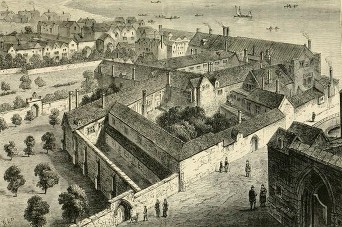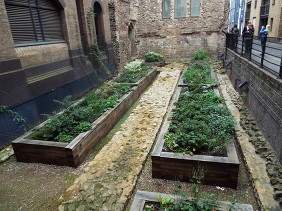





Exploring Southwark and discovering its history


Winchester Palace


Winchester Palace in Clink Street was built in the early 12th century, a London residence for the Bishops of Winchester. Winchester was the capital of London until the Norman Conquest but gradually London became more important, both as a seat of government and centre of commerce, and it was necessary for both ecclesiastics and laymen from other parts of the country to visit London regularly. It soon became apparent that it would be more convenient for regular visitors to own their own houses close to London and both prelates and laymen from the South and South East England established residences in Southwark for its proximity to London as land in the city itself was becoming scarce. Henry of Blois, King Stephen’s brother, was the incumbent Bishop of Winchester who bought the land and accompanying manorial lordship from Bermondsey Abbey in the 1140s.
The Palace of Winchester was just west of the dock at St Mary Overie and the grounds extended west along Bankside, close to where Tate Modern currently stands, with the largest part of the estate comprising fields and pastures to the south. Today’s Park Street is named after the park attached to the Palace. Crops grown on Palace land during the early years included barley, rye, wheat, peas and beans and grain and the Palace ground its cereal in its own mill run on tidal power. Later an orchard was established, and produce grown in 1251 included apples, peaches, nuts, beans, cabbage, parsley and saffron.
The estate kept livestock and grew vines. Surplus produce was sold and part of the land was tenanted. As the area was marshy and prone to flooding, the bishops carried out intensive land drainage involving ditches and sluices, embanking and quay building. Bankside, running along the river and named after the embankment, was first mentioned in 1218 and became infamous for its taverns and brothels, or stews Though within the Bishop of Winchester's estate, the stews had been transferred to leaseholders, or alienated, but they were still under the jurisdiction of the Bishop of Winchester. The whole area between Bankside and Maid(en) Lane became known as 'The Stews'. There were three pike ponds that bred fish commercially for the table that were known as stew ponds after the brothels. Alternatively it has also been suggested the fish ponds came first and the brothels were named euphemistically after them. The Palace of Winchester had its own prison called The Clink that gave rise to the area becoming known as the Liberty of the Clink with the thoroughfare running north of the Palace becoming known as Clink Street.
John Stow described Winchester Palace in 1598 as a “very fayre house, well repaired, and hath a large wharfe, and landing place, called the Bishoppe of Winchester’s staires” but in truth, by this time, the greatest days of the palace were over. The Bishop of Winchester, Stephen Gardiner, had played a prominent part during the Reformation and had managed to hold on to the Clink Liberty but when Edward VI came to the throne he was imprisoned in the Tower for five years and his lands confiscated due to doctrinal differences. When Mary succeeded her brother Edward VI, he was freed from the Tower and his lands restored but already tenements had been built on the land and existing buildings divided. During the Commonwealth, the estate and manorial rights were sold by the Trustees of the Sale of Church Lands to Thomas Walker of Camberwell for £4380 but when the monarchy was restored in 1660 the estate was returned to the Bishop. By now though he had acquired a house in Chelsea and so much building had been carried out on his former lands that he did not return. An Act of Parliament was passed that allowed the Bishop to let out the land and the tenements already built.
After these events it was generally believed nothing of the Palace remained until a fire that started in the mustard factory on the other side of Clink Street destroyed warehouses that had been built around the palace. Entire walls were revealed, including a complete cross-wall of the Great Hall containing the wonderful rose window. Much of what was revealed by the fire either fell down or was subsequently demolished but the building’s owner decided to preserve the wall containing the rose window and, what seems extraordinary today, rebuilt new warehouses around it. A map of 1872 shows flour and hop warehouses built over the site of the Palace.
And the Palace remained hidden again until once more revealed, this time by bombings in the second world war. The demise of the London docks led to the warehouses falling into disuse and Clink Street and the surrounding area was deserted. It was designated a Conservation Area in the mid 1970s. Some warehouses were demolished and revealed not just further remains of Winchester Palace but beneath the Palace the remains of a large Roman building, probably a bath house for use by military personnel. The 14th century rose window, burnt and in a ruinous state, was restored in 1972. The remains of the Palace are Grade II* listed.

Recently a medieval garden has been installed within the sunken space that was formerly the floor of the Great Hall and overlooked by the wall containing the rose window. Further information can be found on the Bankside Open Spaces Trust website.
Web discoveries
- UK Casino Not On Gamstop
- UK Casino Not On Gamstop
- Non Gamstop Casino
- Casinos Not On Gamstop
- Non Gamstop Casinos
- Non Gamstop Casinos
- Non Gamstop Casino
- Casino Sites Not On Gamstop
- Slots Not On Gamstop
- Casinos Not On Gamstop
- UK Betting Sites Not On Gamstop
- UK Casino Not On Gamstop
- Best Non Gamstop Casinos
- Betting Sites
- Non Gamstop Casino Sites UK
- Best Non Gamstop Casinos
- Non Gamstop Casino
- Casinos Not On Gamstop
- Non Gamstop Casino Sites UK